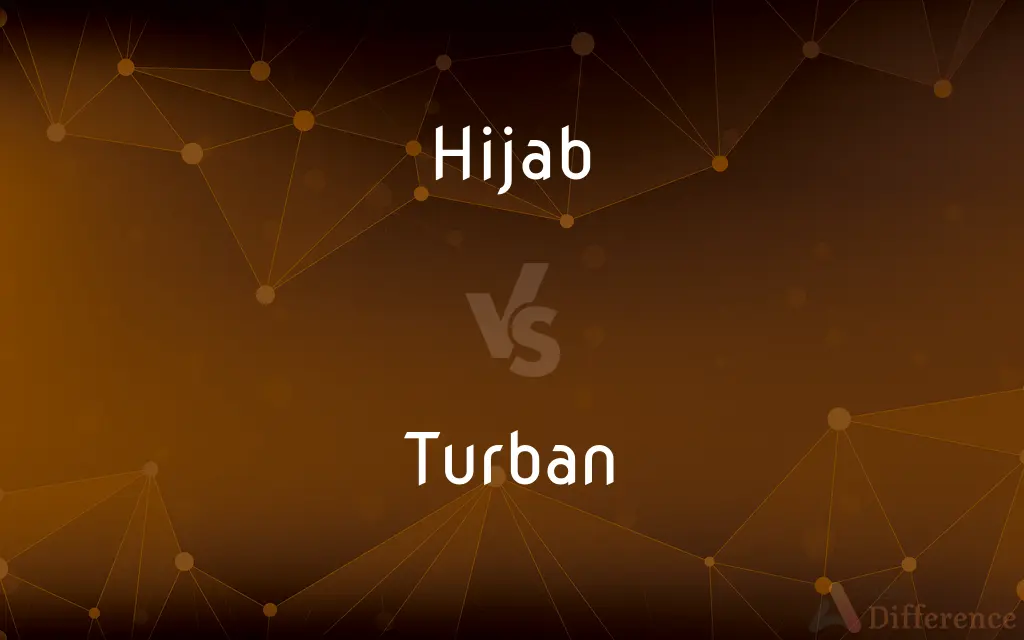Hijab vs. Turban — What's the Difference?
By Tayyaba Rehman & Urooj Arif — Updated on March 15, 2024
Hijab is a head covering worn by Muslim women for modesty, while a turban is a headwrap used for cultural or religious reasons.

Difference Between Hijab and Turban
Table of Contents
ADVERTISEMENT
Key Differences
The hijab is primarily worn by Muslim women as a symbol of modesty, privacy, and morality. It covers the head and chest, and its use is influenced by religious guidelines. The turban, on the other hand, is a long piece of cloth wrapped around the head, commonly worn by men in various cultures and religions, including Sikhism, Islam, and certain Christian and Jewish communities.
While the hijab is specifically associated with women and is part of Islamic dress code aimed at modesty, the turban serves multiple purposes, including protection from the environment, a sign of commitment to one's faith, and a symbol of honor. The turban is not gender-specific, although its association varies by culture and religion.
The origins of the hijab and turban differ significantly. The hijab has its roots in Islamic teachings and is mentioned in the Quran in the context of modesty. The turban, however, has been used in many parts of the world for centuries, predating many modern religions and serving various practical and ceremonial purposes.
In terms of cultural significance, the hijab is a subject of much debate and discussion, symbolizing different things to different people: oppression, freedom, identity, or faith. The turban, while also a significant religious and cultural symbol, often represents specific cultural identity and religious dedication, particularly in Sikhism where it is a mandatory part of men's attire.
Both the hijab and turban can be seen as expressions of personal faith and cultural identity. However, the societal reception and interpretation of these garments can vary widely, with individuals sometimes facing discrimination or support depending on the context and location.
ADVERTISEMENT
Comparison Chart
Primary Wearers
Muslim women
Men and women in various cultures and religions
Purpose
Modesty, privacy, and morality in Islam
Protection, religious commitment, cultural identity
Religious Association
Islam
Sikhism, Islam, some Christian and Jewish sects
Gender Association
Primarily women
Not gender-specific, varies by culture
Cultural Significance
Symbolizes modesty, identity, sometimes debated
Represents honor, faith, and cultural identity
Compare with Definitions
Hijab
A head covering worn by Muslim women for modesty.
She chose a colorful hijab to express her personal style while adhering to her faith.
Turban
A headwrap worn for cultural or religious reasons.
His turban, intricately wrapped, signified his deep Sikh faith.
Hijab
Part of the Islamic dress code.
The hijab is one aspect of the broader Islamic dress code emphasizing modesty.
Turban
Common in various cultures and religions.
Turbans have been worn by people from diverse backgrounds, each with its significance.
Hijab
Symbolizes privacy and morality in Islamic culture.
For her, wearing the hijab was an important expression of her religious beliefs.
Turban
Part of traditional attire in many regions.
In parts of Africa and Asia, the turban is a key element of traditional attire.
Hijab
Reflects personal faith and identity.
Her hijab was not just a piece of cloth but a reflection of her identity as a Muslim woman.
Turban
Can symbolize honor and commitment.
In many cultures, wearing a turban is a sign of honor and religious commitment.
Hijab
Can be a subject of political and social debate.
The discussion around the hijab often intersects with issues of freedom and women's rights.
Turban
Not limited by gender.
While turbans are often associated with men, women in some cultures also wear them.
Hijab
A hijab (; Arabic: حجاب, romanized: ḥijāb, pronounced [ħɪˈdʒaːb] in common English usage) is a religious veil worn by Muslim women in the presence of any male outside of their immediate family, which usually covers the hair, head and chest. The term can refer to any hair, head, face, or body covering worn by Muslim women that conforms to Islamic standards of modesty.
Turban
A turban (from Persian دولبند, dulband; via Middle French turbant) is a type of headwear based on cloth winding. Featuring many variations, it is worn as customary headwear by people of various cultures.
Hijab
Any of several cloth head coverings worn by Muslim women.
Turban
A headdress consisting of a long piece of cloth wound around a small cap or directly around the head, traditionally worn in North Africa, the Near East, and Central and South Asia.
Hijab
The veiling of women in some Islamic societies, customarily practiced in order to maintain standards of modesty.
Turban
A hat that resembles a turban, especially a brimless, close-fitting cap of draped fabric.
Hijab
(countable) A traditional headscarf worn by Muslim women, covering the hair and neck.
Turban
A man's headdress made by winding a length of cloth round the head.
Hijab
A headscarf worn by Muslim women; conceals the hair and neck and usually has a face veil that covers the face
Turban
A woman's close-fitting hat with little or no brim.
Hijab
The custom in some Islamic societies of women dressing modestly outside the home;
She observes the hijab and does not wear tight clothing
Turban
The complete set of whorls of a spiral shell.
Turban
A kind of headdress worn by women.
Turban
The whole set of whorls of a spiral shell.
Turban
A traditional Muslim headdress consisting of a long scarf wrapped around the head
Turban
A small round woman's hat
Common Curiosities
What does the turban symbolize?
The turban can symbolize honor, religious commitment, and cultural identity, varying by culture and religion.
Is the hijab worn only for religious reasons?
Primarily, yes, though it can also express personal identity and cultural heritage.
Can anyone wear a turban?
While culturally and religiously significant, anyone can wear a turban, but understanding its significance in different cultures is important.
What is a turban?
A headwrap used for various cultural, religious, and practical purposes, notable in Sikhism and other cultures.
What is a hijab?
A head covering worn by Muslim women as a sign of modesty and privacy, guided by Islamic principles.
Why do women wear the hijab?
Muslim women wear the hijab as a sign of faith, modesty, and privacy, following Islamic teachings.
Do hijabs and turbans have different styles?
Yes, both can vary in style, color, and manner of wearing, reflecting personal choice and cultural variations.
Are hijabs and turbans only for specific genders?
Hijabs are mainly worn by women, while turbans are worn by both men and women, depending on cultural and religious practices.
How are hijabs and turbans viewed in different countries?
Perceptions vary widely, from symbols of identity and faith to subjects of controversy and misunderstanding.
Are there laws regulating the wearing of hijabs or turbans?
Yes, some countries have laws affecting the wearing of religious symbols, including hijabs and turbans, often sparking debate.
What is the significance of the turban in Sikhism?
In Sikhism, the turban is a mandatory part of men's attire, symbolizing faith, honor, and dedication.
What is the historical origin of the hijab?
The hijab's origins are rooted in Islamic teachings, emphasizing modesty for women.
How do individuals personalize their hijabs or turbans?
Through choices in color, fabric, style, and wrapping technique, individuals personalize these garments to express their identity and style.
Can the hijab and turban be worn together?
Yes, in some cultures and contexts, individuals might wear both, depending on personal and religious preferences.
How do societal reactions to the hijab and turban differ?
Reactions can range from respect and acceptance to misunderstanding and discrimination, influenced by cultural and political climates.
Share Your Discovery

Previous Comparison
Breve vs. Macron
Next Comparison
Protestant vs. OrthodoxAuthor Spotlight
Written by
Tayyaba RehmanTayyaba Rehman is a distinguished writer, currently serving as a primary contributor to askdifference.com. As a researcher in semantics and etymology, Tayyaba's passion for the complexity of languages and their distinctions has found a perfect home on the platform. Tayyaba delves into the intricacies of language, distinguishing between commonly confused words and phrases, thereby providing clarity for readers worldwide.
Co-written by
Urooj ArifUrooj is a skilled content writer at Ask Difference, known for her exceptional ability to simplify complex topics into engaging and informative content. With a passion for research and a flair for clear, concise writing, she consistently delivers articles that resonate with our diverse audience.














































